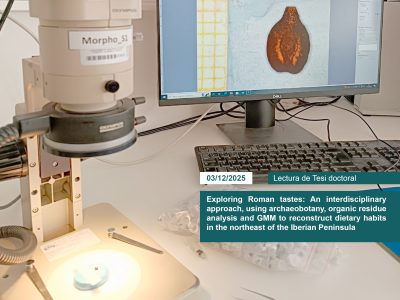
As part of the Interuniversity Doctoral Program in Classical Archaeology (URV–ICAC–UAB), we are pleased to invite you to the public defense of the doctoral thesis by predoctoral researcher Theoni Baniou.
“Exploring Roman tastes: An interdisciplinary approach, using archaeobotany, organic residue analysis and GMM to reconstruct dietary habits in the northeast of the Iberian Peninsula”
The defense will be held in person at the ICAC Auditorium on Wednesday, December 3, 2025, starting at 10:00 a.m.
Members of the Examination Committee
- Dr. Leonor Peña Chocarro, CCHS-CSIC (Chair)
- Dr. Alessandra Pecci, University of Barcelona (Secretary)
- Dr. Efstathia Margariti, The Cyprus Institute (Comittee Member)
Abstract
Theoni Baniou is member of Landscape Archaeology Research Group at the Catalan Institute of Classical Archaeology (ICAC). She did her PhD under the supervision of Dr. Alexandra Livarda and Dr. Núria Romaní Sala. Her doctoral research, titled “Exploring Roman tastes: An interdisciplinary approach, using archaeobotany, organic residue analysis and GMM to reconstruct dietary habits in the northeast of the Iberian Peninsula” combines archaeobotany, organic residue analysis, GMM to reconstruct foodways and socio-economic dynamics in the western provinces of the Roman Empire.
Her research focuses on two key archaeological sites in modern-day Catalonia, the Roman town of Guissona (Iesso) and the Republican military fortress of Puig Castellar of Biosca. By combining archaeobotany, organic residue analysis, and geometric morphometrics (GMM), her work reconstructs the complex relationships between people, plants, and culture in the ancient world. The integration of these complementary methods allows for the exploration of food not only as sustenance but also as a marker of identity, connectivity, and social dynamics.
The thesis presents three main studies: the archaeobotanical analysis of waterlogged and charred plant remains, providing a detailed view of Roman agriculture and diet; the GMM study of grape pips, revealing insights into viticulture, grape diversity, and trade; and the organic residue analysis of ceramic vessels, identifying traces of food preparation and consumption practices. Together, these approaches illuminate how food production and culinary choices evolved through time, reflecting adaptation, innovation, and cultural exchange in the western provinces of the Roman Empire.
This research contributes significantly to debates on Roman economy and identity, while demonstrating the value of interdisciplinary and multiproxy approaches in archaeology.





